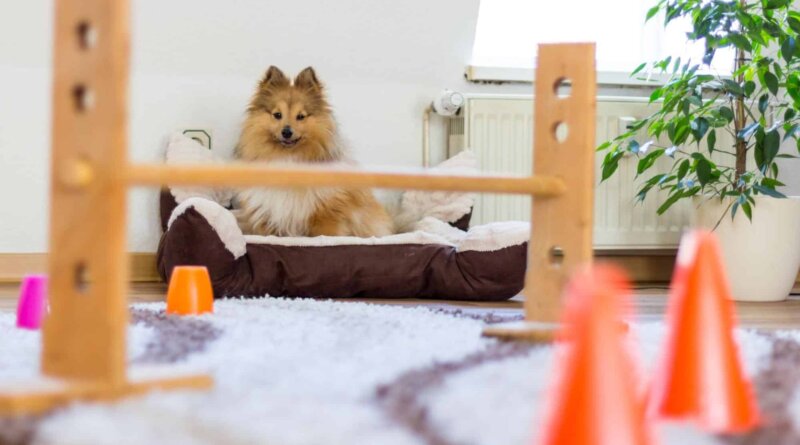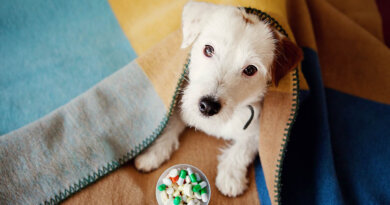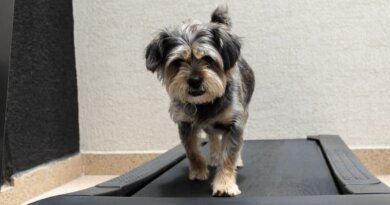Indoor Activities for Dogs | Cesar’s Way
In an ideal world, we would all walk our dogs twice daily, 30 minutes to an hour each time. Unfortunately, our world is not always ideal; in fact, it’s sometimes downright inconvenient! When harsh weather hits or circumstances make it difficult or impossible to venture outside for physical exercise, don’t despair! There are indoor activities for dogs that you can enjoy right in the comfort of your own home.
Benefits of Keeping Dogs Mentally and Physically Stimulated Indoors
Keeping a dog mentally and physically stimulated indoors is essential for overall well-being. Dogs are active animals that require regular exercise and mental stimulation to prevent boredom and destructive behaviors.
By engaging in activities such as games, basic obedience training, and interactive play, you can provide mental stimulation for your dog. Physical exercise can be achieved through indoor games like fetch or setting up obstacle courses. These fun indoor activities keep your dog physically fit, help prevent behavioral issues, and promote a happy and healthy lifestyle for your furry friend.
Outdoor vs. Indoor Activities for Dogs
When it comes to keeping our furry friends entertained and active, indoor and outdoor activities have their benefits. Indoor activities can be an excellent option for days when the weather is not ideal or for dogs with specific health limitations. On the other hand, outdoor activities allow dogs who like to explore their surroundings, get fresh air, and engage in physical exercise. Activities such as walks, hikes, and playing fetch in the park can help dogs burn off energy and stimulate their senses. Ultimately, a combination of both indoor and outdoor activities is ideal to ensure that dogs lead a balanced and fulfilling lifestyle.
Types of Indoor Activities for Dogs
If the weather does not allow outdoor activities with your furry friend, there are various ways to keep them entertained and active inside your home. You may need to adjust some of these ideas according to the size of your home, but keep trying something new. Your dog will love the bonding time, and you will appreciate the physical and mental exercise your pet receives.
Treadmill
The treadmill is a fantastic and very convenient way for your high energy dog to get exercise from the all-important walk without leaving home. Although not a full-time replacement for the walk, the treadmill can supplement daily exercise or substitute it for a short period in the case of bad weather. Remember to take it slow and allow your dog to get accustomed to the treadmill before leaping into a running regimen. Once your dog has the hang of it, don’t be surprised if you enter the room one morning to find him sitting expectantly, waiting to be allowed to play with it!
Practice Calm Submission with Basic Commands
Your dog’s physical needs aren’t the only aspect of him that requires fulfillment. He has psychological needs, too! One activity that only demands a little room to move is the practice of basic training commands. Giving your dog a psychological challenge that forces him to focus and keeps his attention can be a very effective way to drain his energy and strengthen your bond. Remember to keep a bag of his favorite treats on hand as a reward for calm submission when he responds to a command with the correct behavior. That’s the right time to give affection!
Toys and Games
A wide range of dog toys and games have been carefully engineered specifically to engage and improve cognitive functions. Most of these toys involve an incentive like a treat or a provocative scent to keep the dog interested and to reward him for playing. Check with your local pet retail stores and online for the toys you can use to keep your dog psychologically fulfilled into a game!
Use the Stairs
A stairway is a great place to give your dog a physical challenge, particularly for dogs who have high amounts of energy. You can begin by having one person at the top of the stairs and one at the bottom. Each of you can call him and reward him for making the trip. Eventually, train him to go up and down the stairs to get his reward. Make sure it is clear when the activity begins and ends. You don’t want your dog to associate the stairway with excitement, or it can lead to accidents down the road. If you need help, contact a local professional.

Hide and Seek
You can play this with family members or treats. Ask your dog to use his nose to find hidden items or people, and reward him. This can be a fun way to get bored kids involved. Again, be clear when the activity begins and ends. When you decide the game is over, it’s over!
Doga
It may sound silly, but this combination of dog training and yoga can be fun! Yoga and other meditation exercises help you to maintain balance, so what better activity to share with our canine companions? Learn more here.
Playdates With Other Dogs
Playdates with other furry friends can be a great way to provide socialization and exercise for your pal. Dogs are social animals and benefit from interacting with other dogs in a controlled environment. Indoor playdates allow canines to engage in play and exercise regardless of the weather outside. It can also be a good opportunity for them to learn appropriate social behaviors and manners.
Grooming & Relaxation
As simple as it sounds, a bath or a brushing session is an excellent activity for a day spent inside. Any grooming, done with care and love, is a kind of affection, and sharing that affection can bring you two closer together. Be sure to exercise and discipline as much as possible beforehand, though! Below are some ideas for creating a spa-like experience for your pup.
- Indoor Doggy Spa Day
- Dog Massage
- Calming Music and Aromatherapy
- Cozy and Comfortable Resting Areas
Indoor Agility and Obstacle Course
An inside agility and obstacle course for dogs provides a fun and engaging way to exercise and improve their physical and mental abilities. It offers a controlled environment where your furry pal can safely navigate tunnels, ramps, hurdles, and weave poles.
This course enhances dogs’ agility, balance, coordination, and problem-solving skills. It also allows canines and their owners to bond and strengthen their relationships through interactive play and training sessions. An indoor agility and obstacle course is especially beneficial for dogs in inclement weather or urban areas where outdoor space may be limited.
Household Items to Set Up Obstacles for Your Dog to Navigate
- Tunnel: Line up a row of chairs back to back, leaving enough space for your dog to go through. Drape a blanket on top of the chairs to create a tunnel.
- Army Crawl: a coffee table is the perfect height for your dog to get down on all fours and army crawl under the table. Small and medium dogs are the perfect size for the activity. However, some larger dogs would also benefit from it, depending on the height of your table. You can also use some books to customize the height.
- Hurdles: Use a low step stool or laundry basket turned upside down to create a hurdle for jumping over.
- Zig-Zag: Using objects such as shoes, boxes, or books, create a zig-zag pattern. Teach your pet to go through by having them follow you. In no time, they will be going through on their own.
- Stairs: Carpeted stairs work best so your canine can have traction. Stairs are the perfect built-in obstacle in your home to get your furry friend’s blood pumping.
Tips for Introducing Your Dog to Agility Training Indoors
Creating a safe and spacious area where your pup can train is essential. Clear any obstacles or hazards and ensure enough room for your dog to move freely. Introduce your pet to basic agility equipment such as tunnels, jumps, and weave poles.
Use positive reinforcement techniques like treats and praise to encourage your dog to engage with the equipment. Start with simple exercises and gradually increase the difficulty level as your dog becomes more comfortable and confident. Remember to be patient and consistent with your training and prioritize safety.
When To Use Indoor Activities for Dogs
There are several reasons why exercising your dog indoors is beneficial. Indoors is better if the weather is too hot, cold, or rainy. A pack leader’s top priority is keeping your furry friend safe and comfortable. Indoor activities allow your dog to still get exercise and mental stimulation without exposing them to potentially harmful weather conditions.
For those who live in small apartments or don’t have easy access to a yard, indoor activities for dogs are a great way to keep your pup entertained and physically active. A final reason to utilize the indoors for exercise is if your dog is recovering from a recent surgery or injury. Typically, the exercises will be low-impact and allow them to get movement in while healing.
Safety Precautions and Considerations for Indoor Dog Activities
Dog-Proofing the Indoor Space
Dog proofing for playtime inside is vital to ensure your dog’s and your home’s safety. Dogs can be curious and mischievous during playtime, and creating a safe environment to prevent accidents or damage is essential. Start by removing any hazardous items or breakable objects from the play area. Secure loose cords or wires that your dog may chew on. Use baby gates or barriers to restrict access to certain areas of your home.
Using Safe and Durable Toys
Dogs are known for their strong jaws and love for chewing, so providing them with toys specifically designed to withstand their chewing habits is crucial. Safe dog toys are made from non-toxic materials, ensuring your dog does not ingest harmful substances. Also, durable toys are built to last, preventing them from breaking apart easily and becoming a choking hazard.
Supervising Playtime and Interactions
Supervising indoor dog activities and playtime is crucial for several reasons:
- It ensures the safety of both the dog and the owner. Dogs can easily get into mischief or engage in rough play that may lead to injuries, such as knocking over furniture or accidentally biting someone. Owners can intervene by supervising their activities and preventing potential accidents.
- Supervision allows for practical training and behavior management. It provides an opportunity to reinforce positive behaviors and discourage undesirable ones, thus promoting good manners and obedience.
- Monitoring indoor playtime ensures the dog gets appropriate exercise and mental stimulation.
Providing Appropriate Breaks and Rest Periods
Dogs can quickly become overheated and tired during physical exercise, even indoors. As a pack leader, if you fail to offer a break and time to rest, your pet may experience muscle strain and exhaustion. Providing regular breaks allows your dog to cool down, catch their breath, and recharge.
Do you have other ideas? Share them in the comments below.




